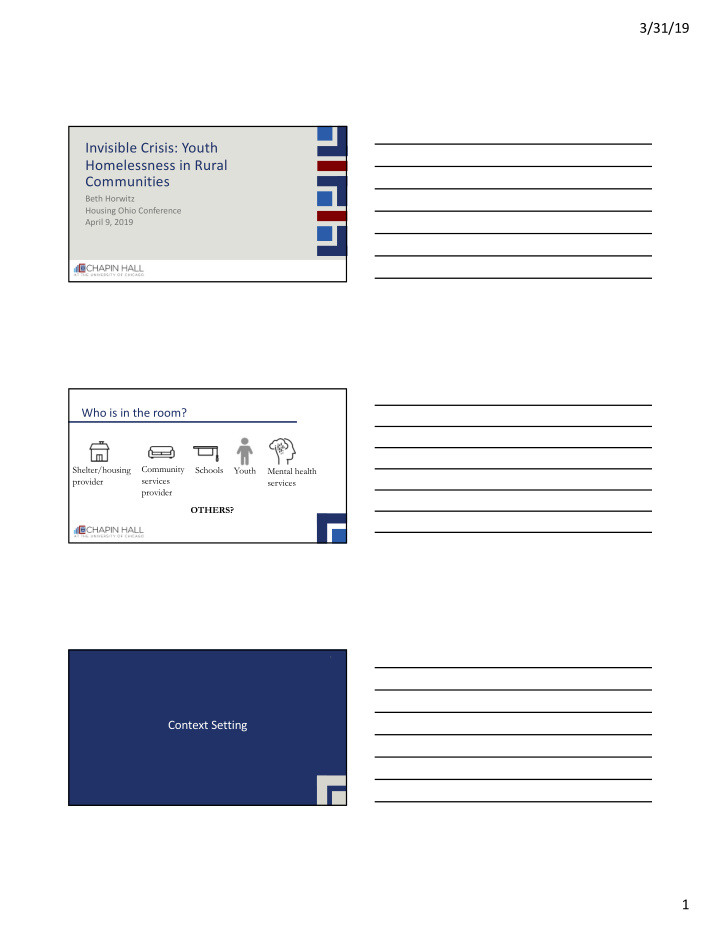



3/31/19 Invisible Crisis: Youth Homelessness in Rural Communities Beth Horwitz Housing Ohio Conference April 9, 2019 Who is in the room? Shelter/housing Community Schools Youth Mental health services provider services provider OTHERS? 3 Context Setting 1
3/31/19 Chapin Hall at the University of Chicago is a research and policy center, focused on a mission of improving the well-being of children and youth, families, and their communities. Chapin Hall provides public and private decision-makers with rigorous data analysis and achievable solutions to support them in improving the lives of society’s most vulnerable children, youth and families. Voices of Youth Count • National policy research initiative designed to fill gaps about: • Who experiences homelessness as a young person? • How and when youth become homeless? • How many youth experience homelessness? • How can we intervene so that youth homelessness becomes rare, brief, and one time? Legislative Impetus 2008 Runaway and Homeless Youth Act Reauthorization • Requires estimates at 5-yar intervals of the incidence and prevalence of RHY, ages 13-25 • Authorizes Congress to appropriate such sums as may be necessary to fund the studies Funds were NEVER appropriated 2
3/31/19 7 “The precise number of homeless and runaway youth is unknown due to their residential mobility and overlap among populations. Determining the number of these youth is further complicated by the lack of a standardized methodology for counting the population and inconsistent definitions of what it means to be homeless or runaway.” Congressional Research Service, 2013 What we know: Previous estimates of youth homelessness • AHAR – Jan. 2016 PIT counts (UHY under 25): 36,000 • MV schools data (2014-15, unaccompanied students): 95,000 • Ringwalt (1992-93 YRBS – 12-month prevalence; youth 13-17): 5% – 7.6% ( 1 – 1.6 million ) Population-based surveys capture far larger numbers than PIT / admin data counts Public-Private Partnership 3
3/31/19 VoYC 22 Partner Communities Comprehensive Data Collection COUNT SURVEYS • Local counts • Youth • National • Households prevalence • Providers Ending Youth Homelessness REVIEWS INTERVIEWS • Intervention • Youth: in-depth evidence experiences • Policy entry points What is “rural”? • No single definition • Classify areas as rural based on range of characteristics, such as population size or density, household density, resident interpretation, and presence (or distance from) metropolitan areas • Rural communities have fewer people spread over a larger landscape, less access to services and economic opportunities, and greater hiddenness of social problems 4
3/31/19 13 Youth Homelessness in Rural Communities About 4.3 million youth, ages 13-25, experience any form of ‘homelessness’ in a year 5
3/31/19 Limited Services • Half of the small VoYC counties had no programs specifically for runaway and homeless youth; those that did had only 1-2 programs • Broader youth serving organizations were primary service providers for youth experiencing homelessness • Lack of services tailored to youth shapes young people’s experiences Coalition Building YOUTH Some youth are at greater risk of homelessness 6
3/31/19 Working across systems 46% 29% Ever in Detention or Ever in Foster Care Incarceration vs. 2% of general youth vs. 15% of general (older) population youth population (Source: VoYC Brief Youth Surveys) Homelessness starts early 9 to 1 in 4 youth 12 6% interviewed in 5 19 to 25 13 to 15 24% 15% communities had prior experiences of family homelessness or 16 to 18 55% housing instability (Source: VoYC In-depth Interviews) Youth homelessness in rural communities looks different than in urban communities 7
3/31/19 Youth experiences of homelessness is fluid 23 “(Camping is) the only place I can stay clean.” Rural youth experiencing homelessness are more likely to be out of school and work than youth in large counties 8
3/31/19 25 What Works? We’re Still Learning… How does your evidence support your claim? e c n e d v i e r u o y s e ? o m d a i w o c l H u r o y t r o p p u s 9
3/31/19 28 OPPORTUNITY www.voicesofyouthcount.org e: bhorwitz@chapinhall.org 10
Recommend
More recommend